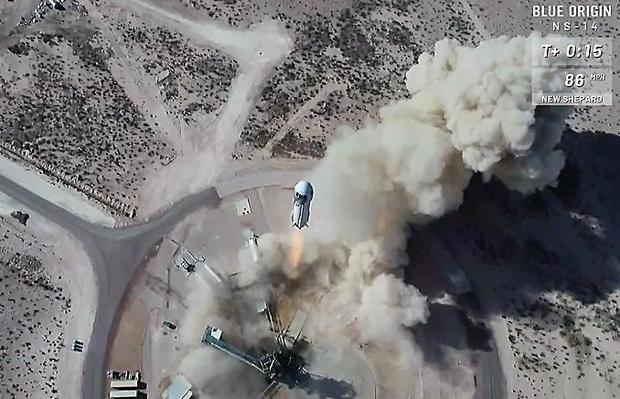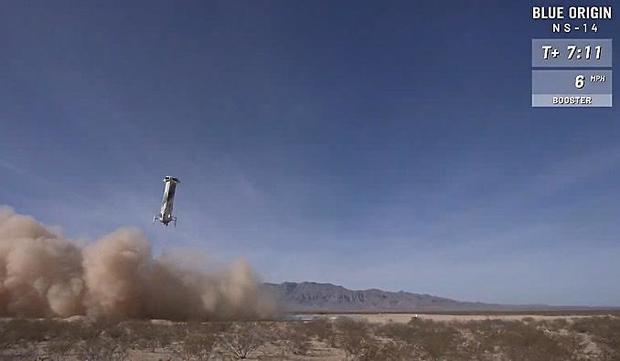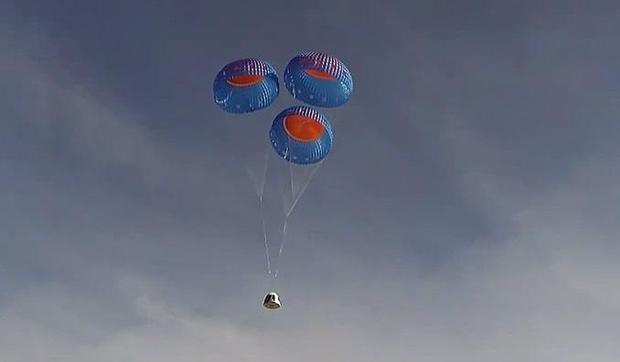Blue Origin launches New Shepard test flight, looks ahead to sending passengers into space
Blue Origin launched its 14th sub-orbital flight of a New Shepard spacecraft Thursday, using its reusable rocket to boost an unpiloted crew capsule out of the discernible atmosphere for a brief sojourn in weightlessness. The mission was to test accommodations, cockpit displays and other systems for upcoming passenger flights.
The hydrogen-fueled rocket's BE-3 engine ignited with a burst of flame at 12:17 p.m. EST, quickly pushing the stubby vehicle away from Launch Site One at Blue Origin's west Texas flight test facility. The company is owned by Amazon founder Jeff Bezos.
The New Shepard rocket reached a maximum velocity of 2,242 mph before releasing the crew capsule two minutes and 40 seconds after liftoff. The spacecraft then soared to an altitude of 66.4 miles (350,827 feet), well above the accepted lower "boundary" of space, before beginning the long plunge back to Earth.
As the capsule descended, the booster homed in on its landing pad, restarting its engine at the last moment to slow down for a slightly off-center touchdown. The capsule floated to a relatively gentle landing a short distance away, slowed as usual by three large parachutes. Mission duration from launch to touchdown: 10 minutes and 15 seconds.
The New Shepard system is designed to carry space tourists, government and civilian researchers and a variety of payloads to altitudes just above the discernible atmosphere, providing a few minutes of microgravity, along with spectacular views through six large windows.
NASA, the Air Force and the Federal Aviation Administration consider 50 miles to be the dividing line between space and the discernible atmosphere while the Fédération Aéronautique Internationale, an international governing body for aviation-related sports and records, puts the threshold at 100 kilometers, or 62 miles.
The New Shepard capsule exceeded both of those standards Thursday.
It was the 14th flight of a New Shepard rocket and capsule since the program's maiden voyage in April 2015 and the first flight for a brand new rocket and spacecraft dedicated to upcoming astronaut missions. No word yet on when piloted flights might begin.
"We're getting very, very close to flying our first astronauts, so that's why it's critical that we test these systems," said launch commentator Ariane Cornell.
For its latest test flight, the crew capsule was outfitted with a variety of upgrades to accommodate those passengers.
"The upgrades include improvements to environmental features such as acoustics and temperature regulation inside the capsule, crew display panels and speakers with a microphone and push-to-talk button at each seat," the company said.
"The mission will also test a number of astronaut communication and safety alert systems. The capsule will be outfitted with six seats, including one occupied by Mannequin Skywalker."
The mannequin is an instrumented passenger stand-in equipped with a variety of sensors to characterize the sounds, vibrations, thrust pressure and other elements of the environment passengers will experience.
In another nod to eventual passenger flights, the New Shepard rocket put the craft into a slow roll as it climbed toward space, testing the techniques that will be used to give future crews panoramic 360-degree views.
New Shepard is a strictly sub-orbital rocket and spacecraft that is not capable of achieving the velocities required to reach low-Earth orbit. It will compete with Richard Branson's Virgin Galactic sub-orbital spaceplane for commercial passengers and payloads.
But Blue Origin also is developing orbit-class New Glenn rockets that will use a powerful new company-designed engine, the BE-4, to help boost large satellites into orbit. The engines also will be used by United Launch Alliance's upcoming Vulcan rocket, intended to replace workhorse Atlas and Delta boosters.
Blue Origin has built a huge rocket factory just outside the Kennedy Space Center in Florida to manufacture New Glenn boosters and is developing a sprawling launch complex at the nearby Cape Canaveral Space Force Station.
The company also is leading a team, one of three, designing a moon lander to carry astronauts to and from the lunar surface in NASA's Artemis program. NASA is expected to award contracts to one and possibly two teams as early as February.







